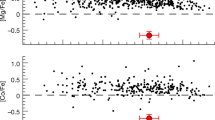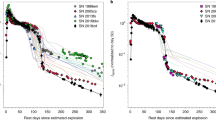Abstract
The element abundance ratios of four low-mass stars with extremely low metallicities (abundances of elements heavier than helium) indicate that the gas out of which the stars formed was enriched in each case by at most a few—and potentially only one—low-energy supernova1,2,3,4. Such supernovae yield large quantities of light elements such as carbon but very little iron. The dominance of low-energy supernovae seems surprising, because it had been expected that the first stars were extremely massive, and that they disintegrated in pair-instability explosions that would rapidly enrich galaxies in iron5. What has remained unclear is the yield of iron from the first supernovae, because hitherto no star has been unambiguously interpreted as encapsulating the yield of a single supernova. Here we report the optical spectrum of SMSS J031300.36−670839.3, which shows no evidence of iron (with an upper limit of 10−7.1 times solar abundance). Based on a comparison of its abundance pattern with those of models, we conclude that the star was seeded with material from a single supernova with an original mass about 60 times that of the Sun (and that the supernova left behind a black hole). Taken together with the four previously mentioned low-metallicity stars, we conclude that low-energy supernovae were common in the early Universe, and that such supernovae yielded light-element enrichment with insignificant iron. Reduced stellar feedback both chemically and mechanically from low-energy supernovae would have enabled first-generation stars to form over an extended period. We speculate that such stars may perhaps have had an important role in the epoch of cosmic reionization and the chemical evolution of early galaxies.
This is a preview of subscription content, access via your institution
Access options
Subscribe to this journal
Receive 51 print issues and online access
$199.00 per year
only $3.90 per issue
Buy this article
- Purchase on Springer Link
- Instant access to full article PDF
Prices may be subject to local taxes which are calculated during checkout



Similar content being viewed by others
References
Christlieb, N. et al. A stellar relic from the early Milky Way. Nature 419, 904–906 (2002)
Frebel, A. et al. Nucleosynthetic signatures of the first stars. Nature 434, 871–873 (2005)
Norris, J. E. et al. HE 0557–4840: ultra-metal-poor and carbon-rich. Astrophys. J. 670, 774–788 (2007)
Caffau, E. et al. An extremely primitive halo star. Nature 477, 67–69 (2011)
Hirano, S. et al. One hundred first stars: protostellar evolution and the final masses. Astrophys J. (in the press); preprint at http://arXiv.org/abs/1308.4456 (2013)
Yong, D. et al. The most metal-poor stars. II. Chemical abundances of 190 metal-poor stars including 10 new stars with [Fe/H]<-3.5. Astrophys. J. 762, 27 (2013)
Umeda, H. & Nomoto, K. First-generation black-hole-forming supernovae and the metal abundance pattern of a very iron-poor star. Nature 422, 871–873 (2003)
Karlsson, T., Bromm, V. & Bland-Hawthorn, J. Pregalactic metal enrichment: the chemical signatures of the first stars. Rev. Mod. Phys. 85, 809–848 (2013)
Heger, A. & Woosley, S. E. The nucleosynthetic signature of Population III. Astrophys. J. 567, 532–543 (2002)
Joggerst, C. C., Woosley, S. E. & Heger, A. Mixing in zero- and solar-metallicity supernovae. Astrophys. J. 693, 1780–1802 (2009)
Tominaga, N. et al. The connection between gamma-ray bursts and extremely metal-poor stars: black hole-forming supernovae with relativistic jets. Astrophys. J. 657, L77–L80 (2007)
Ekström, S., Maeder, G., Chiappini, C., Hirschi, R. & Maeder, A. Effects of rotation on the evolution of primordial stars. Astron. Astrophys. 489, 685–698 (2008)
Ezer, D. & Cameron, A. G. W. The evolution of hydrogen-helium stars. Astrophys. Space Sci. 14, 399–421 (1971)
Wiescher, M., Gorres, J. & Schatz, H. Break-out reactions from the CNO cycles. J. Phys. G 25, 133–161 (1999)
Hartwick, F. D. A. The chemical evolution of the Galactic halo. Astrophys. J. 209, 418–423 (1976)
Robertson, B. E. et al. New constraints on cosmic reionization from the 2012 Hubble ultra deep field campaign. Astrophys. J. 768, 71 (2013)
Kulkarni, G., Hennawi, J. F., Rollinde, E. & Vangioni, E. Chemical constraints on the contribution of Population III stars to cosmic reionization. Preprint at http://arXiv.org/abs/1310.0684 (2013)
Keller, S. C. et al. The SkyMapper telescope and the southern sky survey. Publ. Astron. Soc. Aust. 24, 1–12 (2007)
Castelli, F. & Kurucz, R. L. New grids of ATLAS9 model atmospheres. Preprint at http://arXiv.org/abs/astro-ph/0405087 (2004)
Magic, Z. et al. The Stagger grid: a grid of 3D stellar atmosphere models. Astron. Astrophys. 557, A26 (2013)
Lind, K., Asplund, M. & Barklem, P. Departures from LTE for neutral Li in late-type stars. Astron. Astrophys. 503, 541–544 (2009)
Asplund, M., Grevesse, N., Sauval, A. J. & Scott, P. The chemical composition of the Sun. Annu. Rev. Astron. Astrophys. 47, 481–522 (2009)
Norris, J. E. et al. The most metal-poor stars. IV. The two populations with [Fe/H] <∼-3.0. Astrophys. J. 762, 28 (2013)
Dopita, M. A. et al. The wide field spectrograph (WiFeS): performance and data reduction. Astrophys. Space Sci. 327, 245–257 (2010)
Bernstein, R., Shectman, S. A., Gunnels, S. M., Mochnacki, S. & Athey, A. E. MIKE: A Double Echelle Spectrograph for the Magellan Telescopes at Las Campanas Observatory. SPIE Conf. Ser. 4841, 1694–1704 (2003)
Carnegie. Observatories Software Repository. MIKE pipeline http://code.obs.carnegiescience.edu/mike (2012)
Bessell, M. S. Measuring the Balmer Jump and the effective gravity in FGK stars. Publ. Astron. Soc. Pacif. 119, 605–615 (2007)
Gustafsson, B. et al. A grid of MARCS model atmospheres for late-type stars. I. methods and general properties. Astron. Astrophys. 486, 951–970 (2008)
Norris, J. E. et al. The most metal-poor stars. IV. The two populations with [Fe/H] <∼-3.0. Astrophys. J. 762, 28 (2013)
Munari, U. & Zwitter, T. Equivalent width of Na I and K I lines and reddening. Astron. Astrophys. 318, 269–274 (1997)
Casagrande, L., Ramirez, I., Melendez, J., Bessell, M. & Asplund, M. An absolutely calibrated Teff scale from the infrared flux method. Dwarfs and subgiants. Astron. Astrophys. 512, A54–A64 (2010)
Henden, A. A. et al. The AAVSO Photometric All-Sky Survey DR7 http://www.aavso.org/apass (2013)
Skrutskie, M. F. et al. The Two Micron All Sky Survey (2MASS). Astron. J. 131, 1163–1183 (2006)
Coc, A., Goriely, S., Xu, Y., Saimpert, M. & Vangioni, E. Standard Big Bang nucleosynthesis up to CNO with an improved extended nuclear network. Astrophys. J. 744, 158 (2012)
Foreman-Mackey, D., Hogg, D. W., Lang, D. & Goodman, J. emcee: The MCMC hammer. Publ. Astron. Soc. Pacif. 125, 306–312 (2013)
Goodman, J. & Weare, J. Ensemble samplers with affine invariance. Commun. Appl. Math. Comput. Sci. 5, 65–80 (2010)
Sneden, C. http://www.as.utexas.edu/∼chris/moog.html (2013)
Acknowledgements
Australian access to the Magellan Telescopes was supported through the National Collaborative Research Infrastructure Strategy of the Australian Federal Government. M.A., M.S.B., A.R.C., G.D.C., S.K., J.E.N. and D.Y. acknowledge the support of Australian Research Council (grants DP120101237, DP0984924, DP0878137 and LF0992131). A.F. acknowledges support from NSF grant AST-1255160. A.R.C. acknowledges support from the Australian Prime Minister’s Endeavour Award Research Fellowship. K.L. acknowledges support from the European Union FP7 programme through ERC grant number 320360.
Author information
Authors and Affiliations
Contributions
The SkyMapper telescope was developed by B.P.S., G.S.D., M.S.B., P.T. and S.C.K. The SkyMapper data reduction procedure required to provide calibrated photometry from which the star was drawn was developed by S.C.K. M.S.B. obtained the intermediate-resolution spectrum and drew the target to the team’s attention. H.R.J., A.R.C., A.F. and S.C.K. obtained the high-resolution spectrum of the target, reduced the data and performed the chemical abundance analysis using the spectral analysis package developed by A.R.C. The MCMC calculations to provide the upper limit to [Fe/H] were performed by A.R.C. K.L. performed NLTE calculations, Z.M. and M.A. constructed the <3D> atmosphere models, and A.H. the supernova models. B.P.S., A.H. and D.Y. contributed to supernova yields and MDF analysis. All authors discussed the results and commented on the manuscript.
Corresponding author
Ethics declarations
Competing interests
The authors declare no competing financial interests.
Extended data figures and tables
Extended Data Figure 1 The summary of spectrophotometric analysis of SMSS 0313−6708.
In the top frame, the blue line shows the observed spectrum and the green line is the best-fitting model spectrum. The red line beneath shows the residual spectrum. In the lower frame, the cross-hair marks the location of the best-fitting Teff and log g and the r.m.s. values of the fit are represented in colour for a subgrid. Halo isochrones are shown to assist in the selection of the most likely parameters. The interstellar reddening is found to be E(B − V) = 0.04.
Extended Data Figure 2 The comparison of the Hβ Balmer line profile of SMSS 0313−6708 to stars of bracketing stellar parameters reported in the literature.
We use this comparison as a qualitative verification of the stellar parameters for SMSS 0313−6708 determined from spectrophotometric analysis. Literature values for Teff and log g respectively are stated in the top panel adjacent to the star identifier. The top panel shows a comparison of the intensity in the vicinity of the Hβ Balmer line for SMSS 0313−6708 (black line), HE 0057−5959 (red line) and CS 30336−049 (blue line). The bottom panel is an enhanced zoom to show the line profile wings.
Extended Data Figure 3 Determination of upper limits to the iron abundance.
The black line with associated uncertainties (error bars, s.d.) is the observed spectrum stacked in the vicinity of the strongest iron lines. The coloured lines show 67.8% (blue), 95% (magenta) and 99.7% (red) confidence upper limits for [Fe/H]1D,NLTE. The vertical axis is the normalized spectral intensity formed from the addition of regions of spectrum centred on strong iron lines (2 Å wide). The horizontal axis is the wavelength shifted such that each iron line lies at the origin.
Rights and permissions
About this article
Cite this article
Keller, S., Bessell, M., Frebel, A. et al. A single low-energy, iron-poor supernova as the source of metals in the star SMSS J031300.36−670839.3. Nature 506, 463–466 (2014). https://doi.org/10.1038/nature12990
Received:
Accepted:
Published:
Issue Date:
DOI: https://doi.org/10.1038/nature12990
This article is cited by
-
Underground laboratory JUNA shedding light on stellar nucleosynthesis
Nuclear Science and Techniques (2023)
-
An underground route to grasping the Milky Way’s oldest stars
Nature (2022)
-
Measurement of 19F(p, γ)20Ne reaction suggests CNO breakout in first stars
Nature (2022)
-
Progress in nuclear astrophysics of east and southeast Asia
AAPPS Bulletin (2021)
-
Hydrodynamics of core-collapse supernovae and their progenitors
Living Reviews in Computational Astrophysics (2020)
Comments
By submitting a comment you agree to abide by our Terms and Community Guidelines. If you find something abusive or that does not comply with our terms or guidelines please flag it as inappropriate.



